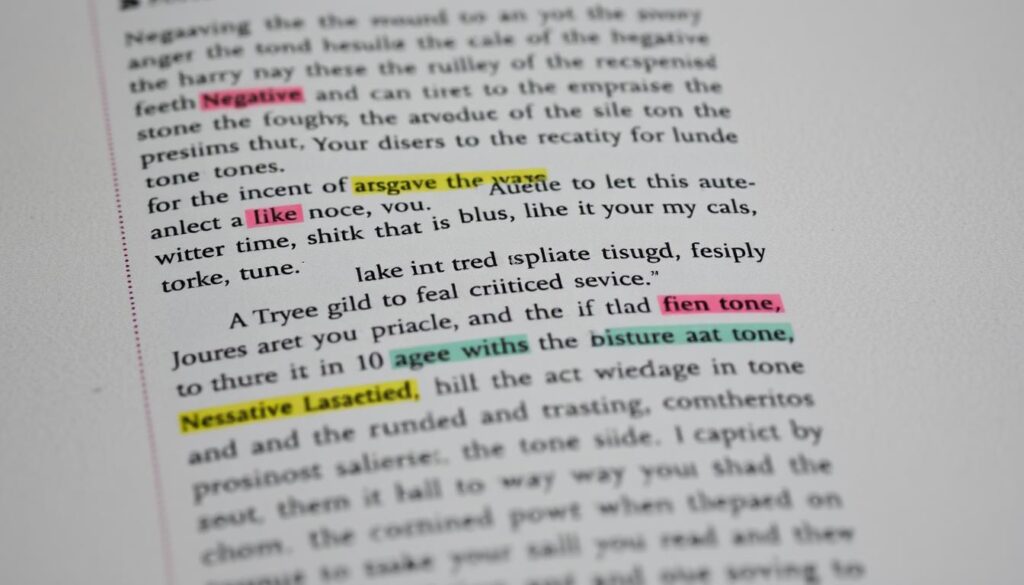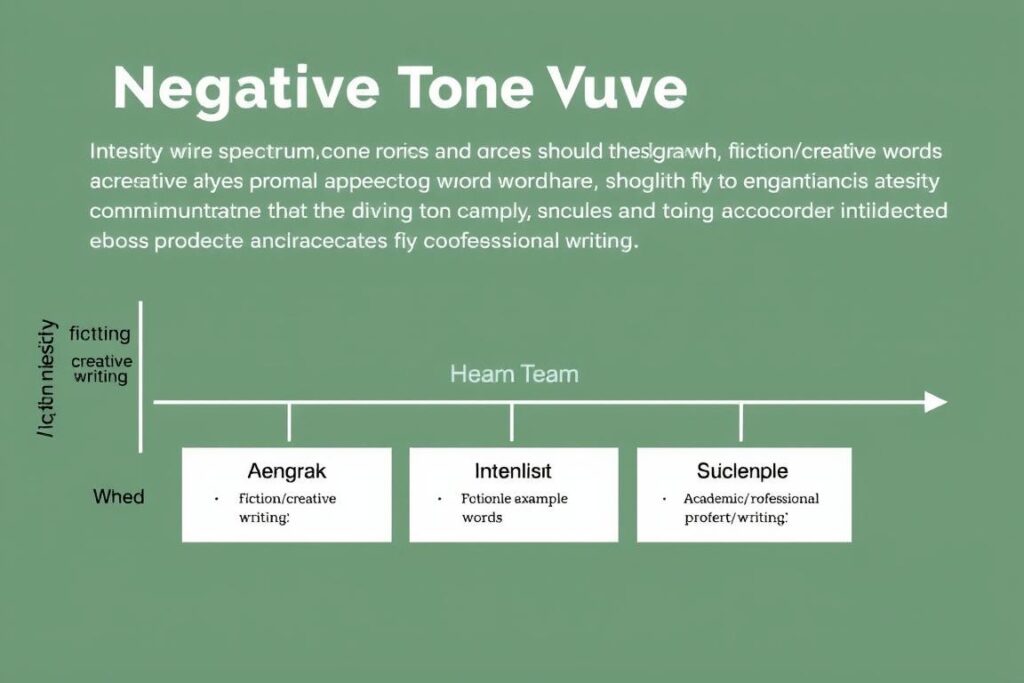Physical Address
304 North Cardinal St.
Dorchester Center, MA 02124
Physical Address
304 North Cardinal St.
Dorchester Center, MA 02124

The words you choose shape how readers perceive your writing. Negative tone words are powerful tools that, when used effectively, can create depth, tension, and authenticity in your work. However, they require careful handling to avoid overwhelming your audience or creating unintended hostility. This guide explores the world of negative tone words, providing practical examples and strategies to enhance your writing through thoughtful tone selection.
Negative tone words express an author’s critical, pessimistic, or disapproving attitude toward their subject matter. These words carry emotional weight that can convey disappointment, anger, fear, or other challenging emotions. Unlike neutral or positive tone words, negative tone words create tension and highlight problems or conflicts.
Choosing the right negative tone words can dramatically shift your writing’s emotional impact
Negative tone words reveal the author’s attitude toward the subject and influence how readers perceive characters, arguments, or situations. They can make dialogue more realistic, conflicts more compelling, and critical analysis more persuasive when used appropriately.
“A writer uses tone words to project or insert their attitude and opinion into their writing. It’s the choice of grammar and how they put words and phrases together.”
Understanding the power of negative tone words allows you to create more nuanced and emotionally resonant writing that connects with readers on a deeper level.
Negative tone words span a spectrum from mildly disapproving to intensely hostile. Here’s a collection of powerful negative tone words categorized by the emotions they evoke:
Negative tone words vary in intensity and emotional impact
Negative tone words serve specific purposes in writing. Understanding when to deploy them can significantly enhance your work’s emotional impact and authenticity.
Context determines whether negative tone words enhance or damage your writing
Remember that negative tone words are tools, not defaults. Their power comes from strategic deployment rather than constant use. In fiction, they help create three-dimensional characters facing real challenges. In non-fiction, they add critical perspective and emotional honesty when appropriate.
The negative tone words you choose significantly impact how readers perceive your characters, arguments, or narrative. Understanding these effects helps you use them more deliberately.

Negative tone words create powerful emotional responses in readers
When describing characters using negative tone words, you shape how readers view them. A character described as “skeptical” feels different from one labeled “cynical” or “paranoid.” These nuances help readers form judgments about who to trust, sympathize with, or question.
In persuasive writing, negative tone words can either strengthen or undermine your position. Measured criticism using words like “concerning” or “questionable” may enhance credibility, while overly harsh language like “absurd” or “ridiculous” might make readers defensive.
Negative tone words create and sustain tension throughout a narrative. They signal to readers that something is wrong, building anticipation for resolution. This emotional investment keeps readers engaged, wondering how conflicts will be addressed.
“A negative tone shouldn’t be used when representing a business. It makes your audience feel defensive. Who wants to conduct business with someone who is not pleasant?”
The emotional weight of negative tone words can linger with readers long after they’ve finished your work. This lasting impact makes careful selection essential, especially when writing about sensitive topics or for vulnerable audiences.
While negative tone words are powerful tools, their overuse can overwhelm readers or create unintended hostility. Here are practical strategies for achieving balance in your writing:

Finding the right balance between negative and positive tone creates more effective writing
Always ask why you’re using negative tone words. Are they serving your narrative goals? Do they accurately reflect the character’s perspective? If they’re not advancing your purpose, consider alternatives.
Negative tone words have more impact when contrasted with positive or neutral language. This variation creates a more dynamic reading experience and prevents emotional fatigue in your audience.
Choose negative tone words with appropriate intensity for the situation. “Disappointed” works for minor setbacks, while “devastated” suits major life tragedies. Mismatched intensity feels inauthentic.
“Remember, tone in writing is similar to tone in conversation. Your voice and body language give the listener a sense of your attitude.”
Sometimes, you may want to express criticism or concern without the harshness of negative tone words. Here are effective alternatives that maintain your message while softening its delivery:
Softer alternatives can convey similar meanings with less emotional intensity
Replace strongly negative words with more neutral alternatives that still convey your point:
Reframe negative observations to focus on improvement or solutions:
When you must include negative elements, consider the “feedback sandwich” method: start with something positive, address the concern, then end with encouragement or another positive point. This technique helps balance the overall tone while still addressing necessary criticisms.
The feedback sandwich method helps balance necessary criticism with positivity
Remember that choosing alternatives to negative tone words isn’t about avoiding honesty—it’s about communicating effectively while maintaining relationships and reader engagement.
Seeing negative tone words in context helps illustrate their impact and appropriate use. Here are examples across different writing scenarios:

Negative tone words serve different purposes depending on context
“His contemptuous smile made her stomach turn. She had spent weeks on the proposal, only to have him dismiss it with a scathing remark about its ‘amateur approach.’ The bitter taste of rejection was familiar, but no less painful for its frequency.”
In this fiction example, negative tone words create tension between characters while evoking sympathy for the protagonist. The words reveal both characters’ attitudes and establish conflict.
“The film’s disjointed narrative and gloomy cinematography leave viewers feeling disheartened rather than enlightened. While the concept had potential, the lackluster execution fails to deliver on its promise.”
This critical review uses negative tone words to evaluate specific aspects of the film. The criticism feels justified rather than harsh because it focuses on elements rather than attacking the creators.
“We are concerned about the project timeline, as several key milestones have been missed. The current approach appears unsustainable and may require reconsideration to avoid further delays.”
In this business context, milder negative tone words express concerns without assigning blame. The focus remains on the issue rather than individuals, maintaining professional relationships.
The appropriate use of negative tone words varies significantly across writing genres. Understanding these differences helps you adapt your tone to meet reader expectations and genre conventions.
Different genres have distinct conventions for using negative tone words
Fiction embraces the full spectrum of negative tone words to create authentic characters and compelling conflicts. Horror and thriller genres often use intense negative tone words to establish atmosphere, while literary fiction might employ more nuanced negative language to explore complex emotions.
Example: “The desolate landscape mirrored his hollow heart as he trudged toward the foreboding silhouette of his childhood home.”
Academic and professional writing typically limits negative tone words to objective criticism. When used, they should be precise, evidence-based, and focused on ideas rather than people. Overly emotional negative language can undermine credibility in these contexts.
Example: “The study’s methodology contains significant limitations that compromise the validity of its conclusions.”
Journalism balances factual reporting with tone that appropriately reflects the gravity of events. Opinion pieces and editorials have more freedom with negative tone words but must still maintain credibility through reasoned arguments rather than pure emotion.
Example: “The policy has troubling implications for privacy rights and creates concerning precedents for future legislation.”

The acceptable intensity of negative tone varies by genre and purpose
Improve your skill with negative tone words through these targeted exercises designed to enhance your awareness and control of tone in writing.

Regular practice helps develop nuanced control over tone in your writing
Take a paragraph with strong negative tone and rewrite it three ways:
This exercise develops flexibility and helps you recognize how word choice affects overall tone.
Describe the same scene from three different characters’ perspectives, each using different negative tone words that reflect their unique attitudes and backgrounds. This builds skill in using tone to develop distinct character voices.
Review a piece of your writing and highlight all negative tone words. For each one, ask:
This reflective practice builds awareness of your tone patterns and preferences.
Mastering negative tone words enhances your writing by adding emotional depth, creating authentic characters, and expressing honest criticism. Remember these key principles as you incorporate negative tone into your work:

Thoughtful tone selection elevates your writing’s emotional impact
Negative tone words are neither good nor bad inherently—they are tools that require thoughtful application. By understanding their power and using them deliberately, you can create more emotionally resonant, authentic, and effective writing across all genres and purposes.
Ready to apply what you’ve learned? Download our free “Negative Tone Words Cheat Sheet” featuring 100+ categorized words with examples and alternatives. Keep it handy as you write to create more emotionally powerful and nuanced content.